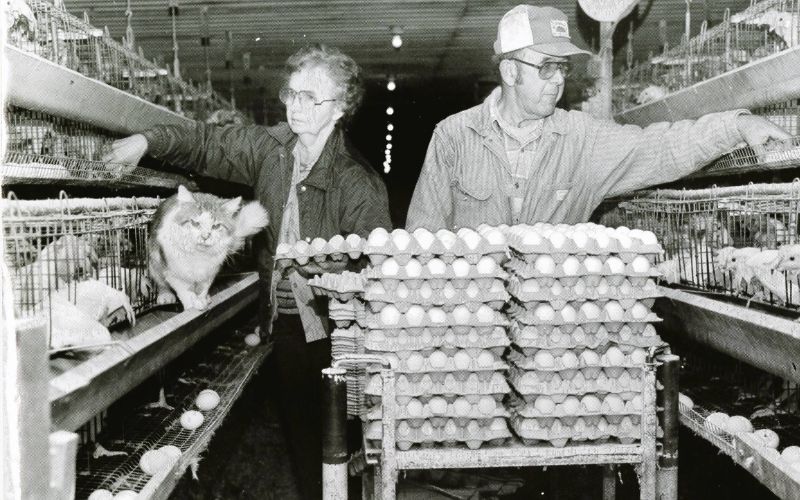By: Mary E. Mortimer
James Grandstaff and Lura Miller were married in DeGraff on June 29, 1941. James worked at Monarch in Sidney and Lura worked at the DeGraff Canning Factory. Two years after they were married, Mr. Grandstaff was drafted into the U.S. Navy and stationed at the Great Lakes Naval Base. Mrs. Grandstaff moved to the naval base and resided there while her husband served our country during World War II from 1943 to 1945.
After his military service, the Grandstaffs returned to DeGraff and bought a farm on State Route 47 near Mr. Grandstaff’s family home. They started their farm with 125 head of beef cattle, a few chickens, and they planted grain crops. The Grandstaffs had two children, Ronald and LuCinda who helped their parents with the farm.
In the late 1960s, the Grandstaffs started doing research about starting their own egg farm. They traveled around the state looking at different setups and then made plans to start their own facility. They built a 41-by-200-foot building that could accommodate 11,000 hens and purchased all the equipment needed, which included thousands of wire cages that were assembled by the entire Grandstaff family.
Along with the egg business, the Grandstaffs continued to farm nearly 400 acres of corn, wheat, and soybeans to help minimize the cost of feeding their hens. Once their egg business was established and successful, they sold their beef cattle.
Mr. Grandstaff ground all the feed for the chickens and added hard shell calcium. He was very meticulous about the quality of the eggs and adjusted the feed as needed to improve the eggshells and yolks. They also paid particular attention to temperature and humidity in the buildings as that could affect the grade of the eggs.
Their farm life was a tough seven-day-a-week job that required the Grandstaffs to rise early every morning. They typically began gathering eggs by hand at 6:00 am. In the main building, approximately 8,300 eggs per day rolled out into wire “troughs” that lined the aisles. It took them about 1 ½ hours to gather the eggs.
After gathering eggs at the main building, they walked to two smaller unattached buildings that housed more chickens and collected about 2,000 more eggs. Then they hand-fed the hens which took another hour or more. In the evening, the chickens in the smaller buildings were hand-fed again and their eggs were gathered. Hens in the main building were fed by automatic timers at 2:00 am and 12:30 pm.
By 10:30 am, the eggs were all gathered, and the chickens had been taken care of and the Grandstaffs could finally take a small break and eat breakfast if there was time. The rest of their day was spent on routine matters such as tending to the needs of their flock, maintaining equipment, grinding feed, record keeping, and general farming.
To begin with, the Grandstaffs had a contract to sell their eggs to the Wilson Egg Farm from Springfield, Ohio. The wholesale company’s trucks picked up as many as 168 cases of their eggs weekly (one case held 30 dozen eggs). The Wilson Egg Farm processed, graded, and cleaned the eggs. They then supplied restaurants, grocery, and convenience stores with eggs they purchased from independent farms. Later they contracted with Weavers of Ft. Recovery to buy their eggs.
The Grandstaffs also sold 40 – 50 dozen eggs a day on the honor system on their back porch. They kept dozens of eggs in cartons in a refrigerator where anyone could stop by at any hour and buy eggs. Most of the time people were honest and left the proper amount. On occasion, eggs were taken without payment, and other times more than the asking price was received.
The Grandstaffs kept an average of 14,000 chickens, however, not all the hens produced eggs at the same time. At their peak, a hen lays eggs about 92 percent of the time, then tapers off to about 42 percent. When bird replacement became necessary, they purchased 20-week-old pullets from an Amish chicken farm in Berne, Indiana. The hens began laying at 22 – 24 weeks of age.
The summer months were the most challenging with the fear of a power failure that could have led to the birds overheating or dying from the lack of oxygen. The main egg facility had eight large fans that exchanged 10,000 cubic feet of air per minute providing the much-needed oxygen and cooler air the birds required.
The Grandstaff family worked together on the farm without any outside help. Their grandsons, who lived nearby, helped gather eggs during the busy fall harvest season, and many times on weekends.
In March 1985, the Grandstaff family was honored as the Bellefontaine Examiner’s “Farm Family of the Year”. James and Lura Grandstaff continued their egg farm until they were about 80 years old, and retired from farming altogether when they were 89 years old. James and Lura were married for 75 years. During those years, they worked side by side and with their hard work and dedication, created a very successful family farm.
A special thank you to LuCinda (Grandstaff) Holycross for sharing her family farm history and photos.
Visit the Logan County History Center at 521 E. Columbus Ave., Bellefontaine, Ohio 43311, to learn more interesting aspects of Logan County History.
The History Center is open for tours Wednesday – Sunday from 1:00 pm to 4:00 pm.

















